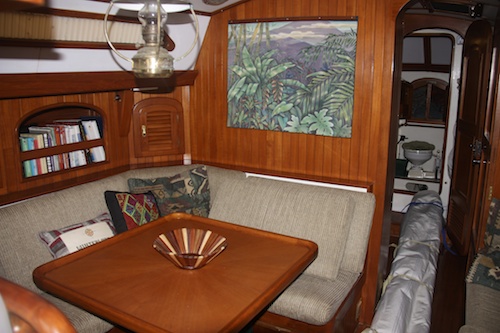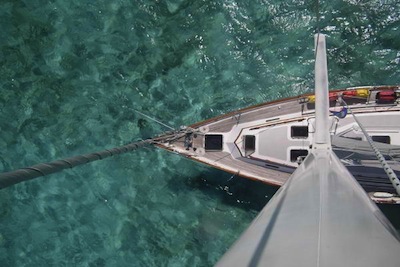Think about it for a minute — when was the last time that anyone came inside your house all stinky, salty and sweaty and immediately plopped down on your expensive furniture? Living aboard a boat, it’s almost impossible to minimize the intrusion from salt and sweat into the inside upholstery (unless you’re one of the lucky ones living aboard a NordHavn or other fancy luxury vessel with A/C all the time, in which case you probably wouldn’t think of going inside salty/sweaty and/or stinky.).

For the rest of us, life in the tropics, enjoying the swimming pool clear water in the aquarium surrounding the boat daily, means the interior upholstery is going to take some abuse no matter how hard we try to avoid it. Unfortunately, Febreze and other “odor eliminators” only do part of the job.

Sooner or later the salt will infiltrate the upholstery making it damp and impossible to completely dry. It’s at this point that mildew and other smelly stinky stuff loves to invade the cushions. Damp and dark means stinky will infiltrate. If it gets bad enough, it will invade not only the upholstery but also the foam cushions themselves. At the point the stink invades the inside foam, there’s no true solution other than replacing the cushions — which isn’t cheap, I might add.
We replaced our foam cushions and upholstery 11 years ago and then went cruising part-time for six years and spent four years living aboard in Southwest Florida for 6-7 months a year.
We decided we had to keep the upholstery clean and keep the mold, mildew and stink out of the foam at all costs. Which isn’t easily accomplished.

Here are some tips:
1. Mildew and other stinkys cannot live in the warm sunshine. Set your cushions outside to “bake” in the sun – we do this after every major damp monsoon and otherwise try to do it at least twice a month, if not weekly. Keep in mind, that salt air can make everything salty and never dry, so try to minimize the time in the sun outside — we’ll usually set cushions out for a half hour, turning them over after 15 minutes. Then check them, if they still seem damp, leave them out for a bit longer.
2. Make sure when you set them outside on deck that the deck is reasonably free of salt – no use adding salt to the cushions by placing them on a salt encrusted deck. After a monsoon, usually most of the salt has been washed away and the cushions are damp, so it’s perfect to put them outside.
3. The stinkys don’t like good ventilation. Make sure the boat is well ventilated, including cross ventilation. Use a solar power exhaust fan (ours is a Nicro from West Marine, mounted in one of our dorade holes) to continually pull inside air out of the boat. Powered by rechargable batteries at night (or when there’s no sun), with an integrated solar panel, ours is like the Energizer Bunny, it just keeps going and going…. knock on wood!)

4. Keep portholes and hatches open as much as possible. Our PortVisors allow us to keep the portholes open in all but the most driving rainstorms and shade/hatch cover canvas on the bow allows us to keep the forward hatches open.
5. When it’s really humid, interior fans help keep air moving, keeping mildew away.
6. A good cockpit enclosure allows air to flow out and in via the companionway without risk of rain or more moisture getting inside.
And at the end of each part-time season, we remove the upholstery from the cushions, launder them in cold water (even though it says dry clean only – there simply aren’t dry cleaners available in most of the places we’ve cruised) and hang them to dry. We have used the air fluff cycle on the dryer to help speed the process, but want to avoid anything that might shrink them!

When we leave the boat, we leave the cushions askew along with the locker doors to allow light and air to reach under each cushion and inside each locker. I also leave Bounce sheets laying around, not sure if they do anything, but they smell fresh. In conjunction with our trusty dehumidifier, we return to a mostly stink free boat each fall.
Keeping my fingers crossed that I didn’t jinx us by writing this post! 🙂














Thanks for the timely post. We are still trying to get rid (old improve) out old boat smell. Any advice for that?
Hi Rich! I’m still sticking with our old but tried and true “How to Get Rid of Boat Odors” post. Here’s a link in case you haven’t seen it. http://commutercruiser.com/how-to-get-rid-of-boat-odors/ Cheers! Jan